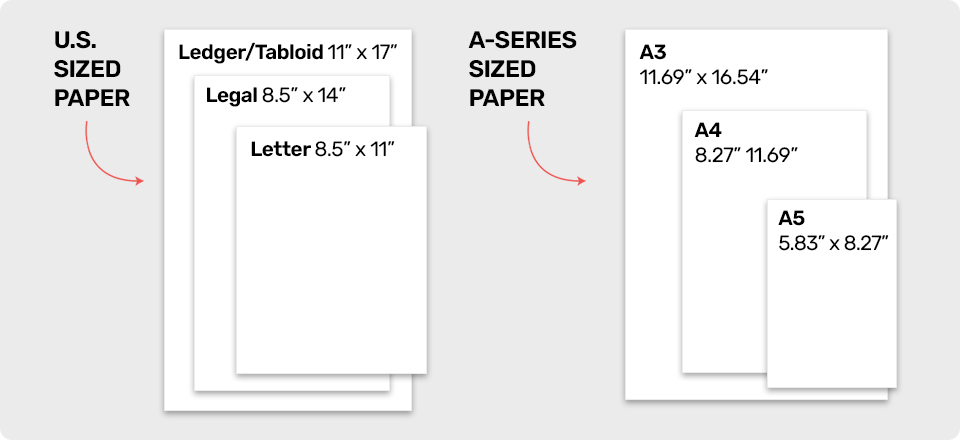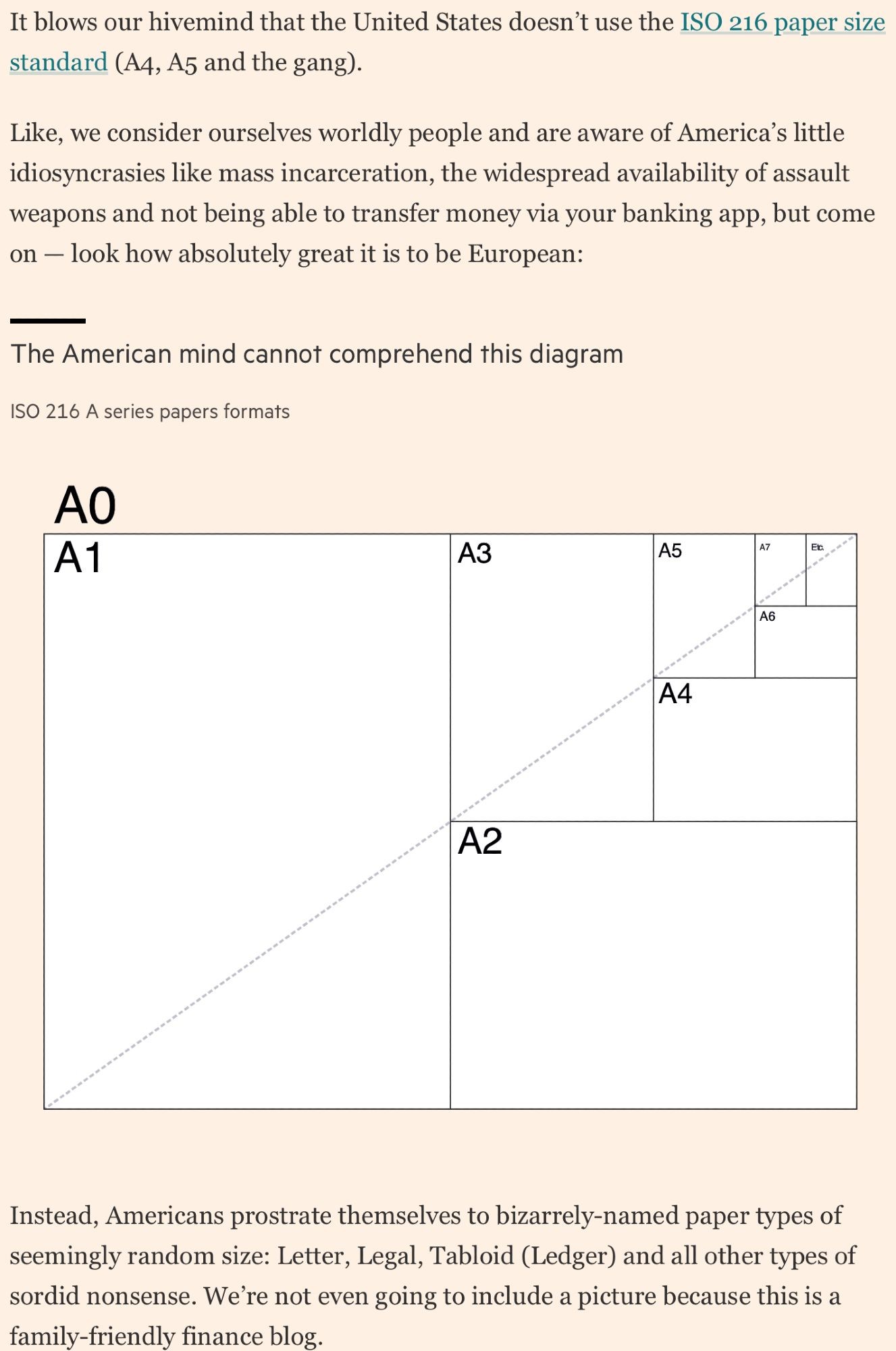Aside from the 1 to √2 ratio, the area of A0 paper is exactly 1m². People behind ISO 216 thought of everyting.
196
Be sure to follow the rule before you head out.
Rule: You must post before you leave.
Which is awesome, because every number up halves the size. This, combined with the standard way that paper weights are given (e g. 80g/m2) allows you to easily calculate how much a piece of paper weights: 1 A4 80g/m2 weighs 5g (1/2^4 * 80g)
Now it makes even more sense!
People behind ISO 216 thought of everyting
how to make a good standard:
step 1: copy from DIN
Wait, the US genuinely doesn't use A4 etc.?
We have trouble fitting all our freedom on your kooky, internationally-recognized sizes
Here’s a comparison using the most sensible units possible:

Ngl as a Canadian, I implicitly thought 8.5x11 was A4. Well that's dumb, we should switch.
I’m British and you are not alone, worse still, I spent a year in the USA and never even noticed.
Letter paper (8.5" x 11" | 215.9mm x 279.4mm) is kinda sorta pretty close to A4 (8.27" x 11.69" | 210mm x 297mm) so without having the two next to each other, it can seem like A4 is just a funny piece of letter, and vice versa. But to answer the actual question, USA and Canada (and apparently the phillipines???) use the "North American Standard" which is a terrifying mess in comparison to the beauty that is the ISO standard.
Edit: typos
Do you have a moment to talk about 8.5 x 11?
Make it quick there's an important call coming in about my auto warranty
Wait a second if the bank app can't transfer money how do they do it? Just barter with guns? Are the bullets like coins?
We involve third parties to help spy on our transactions.

It’s OK, they charge us for the privilege.

We have a fee-free bank-to-bank transfer system that is based on pre-digital technology that takes 2-3 business days. We often call it "direct deposit" or automated clearing house (ACH). It's often used for payroll and paying bills.
Now, we could probably make this payment system instantaneous relatively effortlessly (and thus useful for regular in-store purchases), but the banks lobby against this so they can continue to charge us fees and interest to over-use credit cards. (Interestingly enough, credit and debit cards all use direct deposit on the backend to actual transfer funds between parties).
This is all fine and dandy for most people because they simply can't imagine doing things a more consumer-friendly way.
fun fact: the length to width ratio of ISO 216, √2:1, is the same ratio as the tritone in an equal tempered 12-tone musical scale. If you fold A4 paper in half, you get a piece of paper with the same length to width ratio as before; analogously, if you invert a tritone, you get another tritone.
idk why the image says "european", the standard is worldwide. only north america and parts of latin america don't use it afaik.
The annoying "letter" paper size is for some unknown reason what windows always sets as the paper size unless I change it to A4 manually. Naturally if I forget the printer won't print. US paper sizing - annoying me on the other side of the Atlantic.
File I'm printing: A4 PDF
Default printer setting in Windows: A4
Default setting on printer itself: A4
Setting that gets chosen automatically in the print dialog: Letter
Is this why my printer has wierd size "letter", that is not sized like letter?
Yeah, US software always defaults to their own non-compliant standards instead of looking at the location and determining the default that way.
That is why we in Europe and all the other parts of the world get these strange fuzzy prints where the text is almost unreadable, and is cut off on strange parts in the text.
My country (not USA) uses American paper. I hate it.
It's a beautiful standard that works wonderfully until you have to deal with any actual measurements. 210 x 297 mm - so easy to remember and divide.
i mean, i've never needed to divide the size of a standard sheet of paper - if i need a smaller variant, i can just fold it in half and cut it. when working with paper, it's pretty easy to do physical math, and you rarerly need something that's perfect down to the millimetre
regarding the size- it's just something you learn through life. school supplies lists typically specify the size of notebooks and paper you need to buy in centimetres, so year over year, you quickly learn that A4 is 22:29.7, and the slightly bigger standard notebooks are 24:32
Do Euro printers say PC LOAD A4?
I think they probably do.
I want to only briefly defend the NA system in terms of naming. I get it, I worked in printing for decades, I know how shitty it all can be. But Letter and Tabloid communicate well for something that is otherwise all the fault of press guys.
Well, it's 2024, so they mostly say things like "out of A4 paper - load A4 paper in tray number 3". But yeah, they used to.
As a math nerd, I appreciate the fractaline nature of your paper.
But as an american, what is the practical advantage?? The sizes are so far apart, and you dont get papers with different ratios? Like for example Letter and Legal are both 8.5 inches wide, can be used in any standard cheap household printer, legal is just longer so you can fit more stuff on the page. Letter paper folds into thirds to fit snuggly in an envelope and legal folds into fourths. Other paper sizes are so niche and rarely used why does it matter if theyre a perfect mathematical ratio or not?
The advantage is folding.
When folded at the middle it becomes the next size.
So if you have an A4 paper but don't have the proper C4 envelope, you can fold the paper in half and put it in a C5 envelope. This is standard.
Let's then imagine that you don't have a C5 envelope either, but only have the remaining Christmas card envelopes, which are C6. So you just fold your paper one more time at the middle and it'll fit again.
Also, the area of A0 is 1 square meter. You probably don't nornally have an A0 paper around, but that doesn't matter, because you can take 8 pieces of A3 or 16 pieces of A4 papers, tape them together and it'll be A0.
Now it isn't actually a square meter. It's the same area, but it's not square. No, the length and width makes the golden fucking ratio. This might be irrelevant for a legal document, but it's pretty neat if you want to make a nice drawing.
Paper come in reams. Reams come in boxes. Boxes come on pallets. The paper boxes fit perfectly on a pallet in both length and width, so the layers of boxes can be placed either way in an interlocked pattern. This is mostly a box design thing though. American paper also fit on American pallets, but without the connection through the sizes, you cannot make a pallet with mixed sizes and expect it to fit.
Forgot to add: the real beauty isn't the paper size. It's simply having a standard. Cans and bottles and lots of stuff follow similar metric standards. It's possible to mix everything and still make it fit snuggly on a euro pallet.
Isn't the ratio of length and width of A-papers square root of 2 and not the golden ratio?

Scalability. You can design something in A3/A4 and if you want the page in a smaller, common format, you can print it as A4/A5. This is especially handy for designing flyers, or scaling bigger stuff (like schematics, which are usually drawn on A1/A2) down to print it on household printers.
It's also quite convenient that pretty much anyone has a common understading of what A3/A4/A5/A6 is, when talking about areas in real life.
Also, if you need A5 put only have A4 paper, you can cut it or even split it without scissors. That usually even gets better results, because splitting a piece of paper in two by folding is easier to do precisely that to do it whith scissors.
Making a page longer just to "fit more stuff on it" isnwt really such a great boon, since you always need a cut-off somewhere.
A4 can be folded into thirds as well and smaller envelopes are perfect for A6.
Let's not even start with the metric system (used everywhere) and the imperial system (used in the usa and some african countries).
Don't let the UK get away with their bs as well, they use a mix of metric and imperial. Imo that even worse bc at least america is consistent with their bs measuring system

